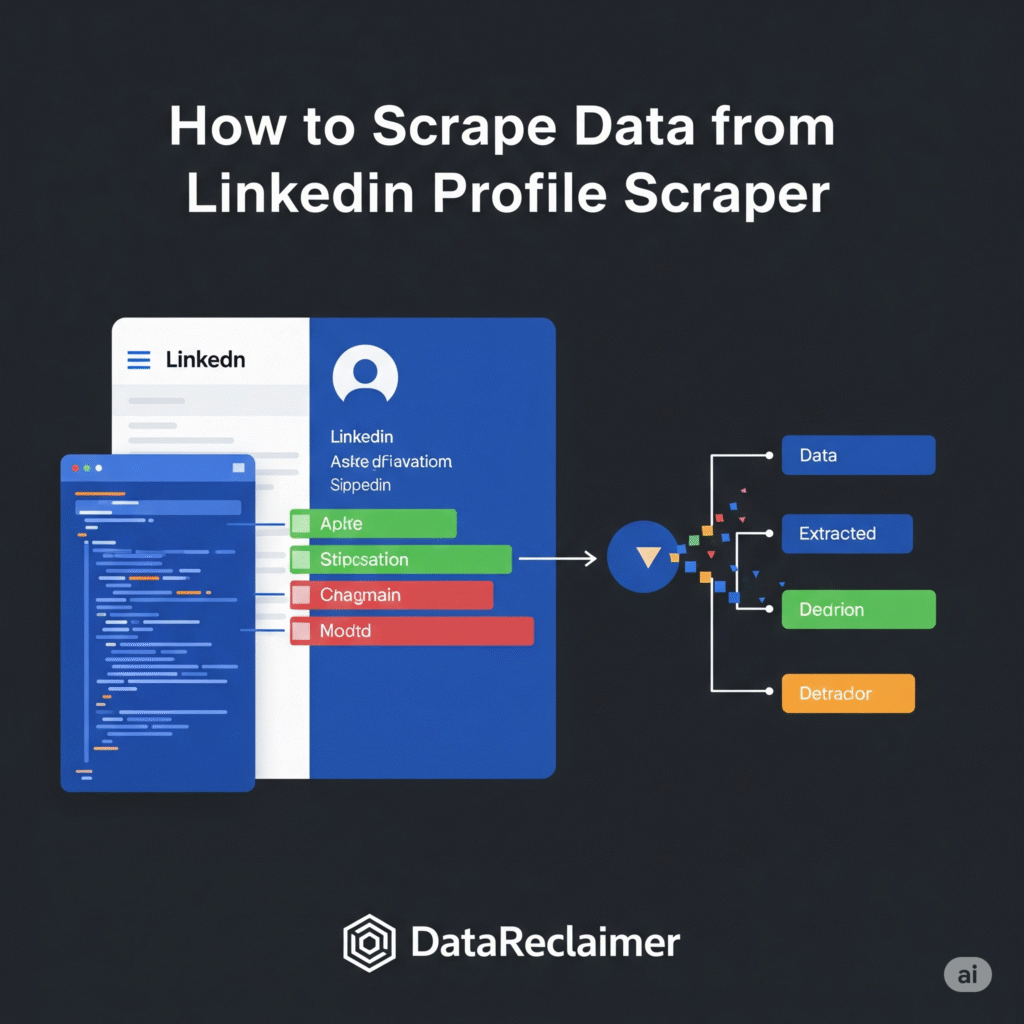
In the current era of aggressive competition among B2B marketers, recruiters, and sales people, LinkedIn profile data is invaluable. Whether you are building a targeted lead list, sourcing top talents, or tracking down competitive intelligence, LinkedIn is a gold mine of professional networks.
However, when it comes to scraping data from LinkedIn, the situation is not as simple as it seems. As a hub of hundreds of millions of professional profiles with valuable contact information, job title, and company information, accessing such data is a violation of the LinkedIn terms of service, which is what prevents most businesses from using it.
Fortunately, there are many ways to legally and safely extract high-quality LinkedIn data for sales and marketing, without violating the TOS.
What Does Scraping LinkedIn Data Mean?
Data scraping refers to the automated process of extracting information from websites using specialised software or scripts. When applied to LinkedIn, this typically involves collecting profile information such as:
- Professional names and job titles
- Company names and locations
- Skills and endorsements
- Educational backgrounds
- Connection counts and activity data
- Contact information (when publicly available)
This data proves invaluable for creating comprehensive lead databases, recruitment pipelines, and market research reports. Sales teams use it to identify decision-makers, whilst recruiters leverage it to find candidates with specific skill sets.
However, scraping LinkedIn data involves accessing information through automated means rather than manual browsing, which creates both technical and legal complications.

Risks of Scraping LinkedIn Data
Before exploring how to scrape data from LinkedIn, it’s essential to understand the significant risks involved:
Violating LinkedIn’s Terms of Service
LinkedIn’s User Agreement explicitly prohibits automated data collection. Violating these terms can result in immediate account suspension and potential legal action.
IP Bans and Legal Notices
LinkedIn actively monitors for scraping activity and can ban IP addresses permanently. The company has pursued legal action against major scraping operations, setting precedents that affect individual users.
Data Inaccuracy and Inconsistency
Scraped data often contains outdated information, duplicate entries, and formatting errors. This leads to poor campaign performance and wasted resources.
Risk to Brand Reputation
Using non-compliant data collection methods can damage your company’s reputation and relationships with potential clients or candidates.
The reality is simple: just because scraping is technically possible doesn’t mean it’s recommended or sustainable for serious business operations.
LinkedIn’s Anti-Scraping Policies
LinkedIn has invested heavily in preventing unauthorised data extraction. The platform employs sophisticated detection systems including:
- Advanced bot detection algorithms that identify automated browsing patterns
- Rate limiting systems that restrict rapid data access
- Legal enforcement teams that pursue violations aggressively
- Technical barriers such as CAPTCHAs and login requirements
These measures have resulted in several high-profile legal battles, with LinkedIn successfully defending its data protection policies in court. The platform has made it clear that accessing profile data through scraping methods can result in permanent account bans and legal consequences.
For businesses serious about compliance and long-term success, these policies make traditional scraping methods unsustainable.
Common LinkedIn Profile Scraping Tools (And Their Issues)
Despite the risks, numerous scraping tools continue to circulate in the market. These typically fall into several categories:
Browser Extensions
Many Chrome and Firefox extensions promise easy LinkedIn data extraction. However, these tools often trigger LinkedIn’s detection systems and provide inconsistent results.
Custom Scripts and Bots
Technical users sometimes develop Python scripts or other automated solutions. These require significant technical expertise and constant maintenance as LinkedIn updates its defences.
Third-Party Scraping Software
Various commercial tools claim to bypass LinkedIn’s protections. Most lack proper compliance measures and offer no protection against account bans.
Important Note: These tools are not endorsed by LinkedIn and carry significant risks. Most provide poor data quality and can compromise your professional accounts.
The fundamental issue with all scraping approaches is that they work against LinkedIn’s systems rather than with them, creating an unsustainable cat-and-mouse dynamic.
Legal & Ethical Alternatives to Scraping
Rather than risking compliance issues, smart businesses choose legitimate alternatives:
LinkedIn’s Official Tools
- LinkedIn Sales Navigator provides advanced search capabilities and lead recommendations
- LinkedIn Recruiter offers comprehensive talent sourcing features
- LinkedIn Marketing Solutions enables targeted advertising and lead generation
API Access
LinkedIn provides limited API access to approved partners for specific use cases. This ensures compliance whilst providing structured data access.
Validated Data Providers
Ethical data companies offer LinkedIn-style professional information through compliant collection methods, providing clean, enriched datasets without platform risks.
These alternatives ensure sustainable access to professional data whilst maintaining compliance with platform policies and data protection regulations.
Why Choose DataReclaimer Instead of Scraping
DataReclaimer represents the smart alternative to risky scraping methods. Instead of fighting LinkedIn’s systems, DataReclaimer provides clean, enriched B2B lead data that surpasses what traditional scraping can deliver.
Key Advantages Over Scraping:
- 100% Compliance Guaranteed DataReclaimer operates within all platform terms of service and data protection regulations, eliminating legal risks entirely.
- Enriched Profile Data Beyond basic LinkedIn information, DataReclaimer provides verified email addresses, phone numbers, and additional contact details that scraping typically cannot access.
- No Account Ban Risks Your professional LinkedIn accounts remain safe since DataReclaimer doesn’t interact with LinkedIn’s platform directly.
- Always Current and Accurate Unlike static scraped data, DataReclaimer’s database receives regular updates, ensuring information accuracy and relevance.
- Ready-to-Use Format Data comes pre-formatted and cleaned, eliminating the time-consuming post-processing required with scraped information.
- Professional Support DataReclaimer provides dedicated customer support and guidance for optimal campaign results.
Use Case Example: Sales Outreach Campaign
Consider a B2B software company targeting marketing directors at mid-size technology firms:
Traditional Scraping Approach:
- Set up scraping tools (technical complexity)
- Risk account bans during data collection
- Clean and verify scraped data manually
- Deal with incomplete contact information
- Constantly update outdated information
DataReclaimer Approach:
- Define target criteria through DataReclaimer’s platform
- Receive validated list with complete contact details
- Import directly into CRM or outreach tools
- Launch campaigns immediately with confidence
- Benefit from ongoing data quality assurance
The DataReclaimer approach eliminates technical headaches whilst delivering superior results through verified, enriched data that drives better campaign performance.
Conclusion
Data scraping from sales navigators may be popular, but it also explains why the method causes more problems than it solves. Whether legal or technical, there are so many reasons not to use this antiquated approach to B2B data collection.
Professional businesses know the only way forward is to work with compliant, quality data providers. DataReclaimer provides the exact professional data you need, without the risks.
Are you ready to take your lead generation to the next level? Reach your target audience with quality, pre-verified B2B data and start getting real results.
Frequently Asked Questions
Is scraping LinkedIn data illegal?
Scraping LinkedIn data violates the platform’s terms of service and can result in legal action. While not necessarily illegal everywhere, it carries significant compliance risks that ethical alternatives like DataReclaimer eliminate entirely.
What is the safest way to get LinkedIn profile data?
The safest approach combines LinkedIn’s official tools with compliant data providers. DataReclaimer offers the most comprehensive solution for accessing LinkedIn-style professional data without platform risks or compliance concerns.
Are LinkedIn scrapers reliable for lead generation?
LinkedIn scrapers typically provide inconsistent, outdated data with high error rates. They also risk account bans and legal issues. Professional data services like DataReclaimer deliver superior accuracy and reliability.
Can I use LinkedIn API for scraping?
LinkedIn’s API has strict limitations and approval requirements. It’s designed for specific partner integrations rather than general data extraction. Most businesses find greater success with dedicated B2B data platforms.
How does DataReclaimer help in extracting LinkedIn-type data legally?
DataReclaimer provides comprehensive B2B professional data through compliant collection methods, offering enriched profiles with verified contact information whilst maintaining full legal compliance and eliminating platform-related risks entirely.

CEO @ Growwitharora | CoFounder @DataReclaimer | Outstanding Leadership award winner | PMP® Certified | Growth Strategist | | $3M+ Invested in Paid Ads | SaaS
